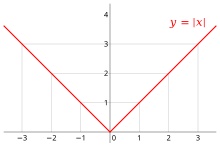DIFFERENTIALITY
Differential means derivative of function exist at the point.
OR
Differential means the functions has not any sharp corner in the given domain.
Example:
The above function is not deferential at X=0 because the function has sharp corner at X=0.
OR
Differential means the functions has not any sharp corner in the given domain.
Example:
The above function is not deferential at X=0 because the function has sharp corner at X=0.
How to find the differential of the function:
- Find the differential of the function at the LHS and RHS of the given point.
- This LHS and RHS value of differential must be equal and equal to value of differential at the given point.
Example: The function f(x) = |x| is not differential at X=0 because the function
LHS Derivative
f(x) = -x
and derivative of
f(x)=-1
and
RHS derivative of
f(x)=1
and value of function at X=0 is zero.
Hence LHS derivative not equal to RHS derivative, not equal to the value at X=0.
hence the function is not differential at X=0
Derivative of function can be found out by at X=c.
limh→0 f(c+h) − f(c)h
NOTE:
If the function is continuous at the given point and it is not necessary it is differential at the given point.
EXAMPLE:



If the function is continuous at the given point and it is not necessary it is differential at the given point.
EXAMPLE:
f(x) = |x|
is continuous at X=0 but not differential X=0 because at the X=0 the function has sharp corner.


DERIVATIVE
Derivative means slope of the function.
or
Slope means the rate of change of curve.
So the derivative of x² is 2x
that is rate of change of y w.r.t. is 2x .

Example: what is the derivative of sin(x) ?
and derivative of sin(x) is cos(x)
i.e.

that is rate of change of sin(x) is cos(x)
Derivative of exponential function:
Y=ex
IS ex
AND
Y=ln(x)
IS 1/X
SOME FUNCTIONS AND THEIR DERIVATIVE:
sin(x) = cos(x)
cos(x)= -sin(x)
tan(x)= sec²(x)
cot(x)=-cosec²(x)
ex = ex
log(x)=1∕x


No comments:
Post a Comment